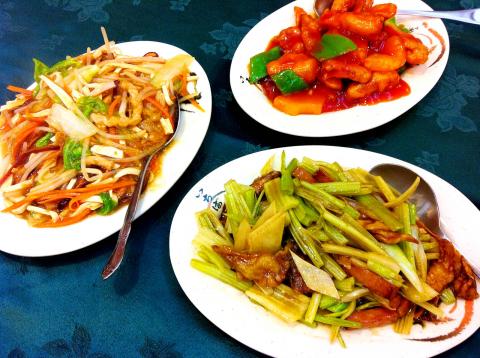A recent visit to King Join, an upscale vegetarian restaurant that serves fancy Beijing-style cuisine, (see the Feb. 18, 2011, edition of the Taipei Times), left me thinking: Sure, these quaint, refined recipes of the imperial court were nice and all, but what about some home-cooked grub for the people?
Enter Jingyuan Beiping Vegetarian Restaurant (京園北平素食館), which serves non-meat versions of standard northern dishes, among other favorites.
Located near Hsingtien Temple (行天宮), Jingyuan is the cleaner looking, and perhaps a tad healthier, version of your neighborhood Beijing/Beiping/(choose your favorite old name for the Chinese capital) “palace” or family-style restaurant.

Photo: David Chen, Taipei Times
It’s easy to forget you’re about to have a vegetarian meal glancing through Jingyuan’s nine-page menu. The selection is a long list of familiar dishes: an assortment of dumplings both steamed and fried, zhajiang mian, or fried sauce noodles (炸醬麵, NT$80), mapo tofu (麻婆豆腐, NT$138), kung pao chicken (宮保雞丁, NT$168), sweet and sour pork chops (糖醋排骨, NT$188). There’s even the basil-infused sanbeiji, or three cup chicken (三杯雞, NT$208).
Jingyuan uses various kinds of tofu and seitan (which is made out of wheat gluten) as meat substitutes, and like many places in Taiwan that cater to Buddhist vegetarian diets, the restaurant doesn’t cook with garlic, onion, shallot or leek.
This fact made the ganbian sijidou, or stir-fried green beans (乾扁四季豆, NT$168), seem even more impressive for its strong and savory flavor. Bits of smoked tofu mimicked minced meat, while zesty notes came from chopped day lily stems (金針筍), also called biyusun, or jade bamboo shoots (碧玉筍), a garlic substitute that looks like green onion. The dish made my dining companion pause after taking her first bite. “Wait. Are you sure this is vegetarian?” she asked.
You won’t ask that question about Jingyuan’s sweet and sour pork (糖醋里肌, NT$188), but it’s still very much worth trying for its sweet and tangy glaze and deep-fried goodness. Another house recommendation is the Hakka stir-fry (客家小炒, NT$188), which has a peppery bite and is chock-full of textures, from the crispness of the julienned celery to the tender bites of tofu.
The combination vegetable stir-fry (炒合菜, NT$168) was much more appetizing than it appeared and turned out to be one of our favorites. It looked like sweet-and-sour soup (酸辣湯), but without the soup. The ingredients were indeed similar: cabbage, carrot, rice noodles and tofu. It was also less greasy than the other stir-fry dishes.
Have the above items with rice or the fried bread (銀絲卷, NT$30 per piece), a mantou with a crispy, slightly sweet golden crust.
Jingyuan’s xiaolongbao (小籠包, NT$120 for a basket of 10) is not going to put Din Tai Fung out of business anytime soon, but these dumplings, filled with rice noodles, finely chopped tofu and vegetable greens, were refined in their own way. I had high hopes for the vegetarian potstickers (素食鍋貼, NT$80 for eight pieces), which were cooked to a perfect golden brown on the bottom, but the all-cabbage filling didn’t work — they fell apart after the first bite.
A few other northern classics on the menu include the xianbing, or meat pie (餡餅), and the xiangchun rolls (香椿卷餅, NT$60), a vegetarian version of fried scallion roll with beef (牛肉捲餅).
It’s hard to beat the real thing, but Jingyuan Beiping Vegetarian Restaurant comes pretty close, and the restaurant offers a nice upscale alternative to Taipei’s ubiquitous vegetarian buffets.

As I finally slid into the warm embrace of the hot, clifftop pool, it was a serene moment of reflection. The sound of the river reflected off the cave walls, the white of our camping lights reflected off the dark, shimmering surface of the water, and I reflected on how fortunate I was to be here. After all, the beautiful walk through narrow canyons that had brought us here had been inaccessible for five years — and will be again soon. The day had started at the Huisun Forest Area (惠蓀林場), at the end of Nantou County Route 80, north and east

Specialty sandwiches loaded with the contents of an entire charcuterie board, overflowing with sauces, creams and all manner of creative add-ons, is perhaps one of the biggest global food trends of this year. From London to New York, lines form down the block for mortadella, burrata, pistachio and more stuffed between slices of fresh sourdough, rye or focaccia. To try the trend in Taipei, Munchies Mafia is for sure the spot — could this be the best sandwich in town? Carlos from Spain and Sergio from Mexico opened this spot just seven months ago. The two met working in the

Exceptions to the rule are sometimes revealing. For a brief few years, there was an emerging ideological split between the Democratic Progressive Party (DPP) and Chinese Nationalist Party (KMT) that appeared to be pushing the DPP in a direction that would be considered more liberal, and the KMT more conservative. In the previous column, “The KMT-DPP’s bureaucrat-led developmental state” (Dec. 11, page 12), we examined how Taiwan’s democratic system developed, and how both the two main parties largely accepted a similar consensus on how Taiwan should be run domestically and did not split along the left-right lines more familiar in

A six-episode, behind-the-scenes Disney+ docuseries about Taylor Swift’s Eras Tour and Rian Johnson’s third Knives Out movie, Wake Up Dead Man, are some of the new television, films, music and games headed to a device near you. Also among the streaming offerings worth your time this week: Chip and Joanna Gaines take on a big job revamping a small home in the mountains of Colorado, video gamers can skateboard through hell in Sam Eng’s Skate Story and Rob Reiner gets the band back together for Spinal Tap II: The End Continues. MOVIES ■ Rian Johnson’s third Knives Out movie, Wake Up Dead Man